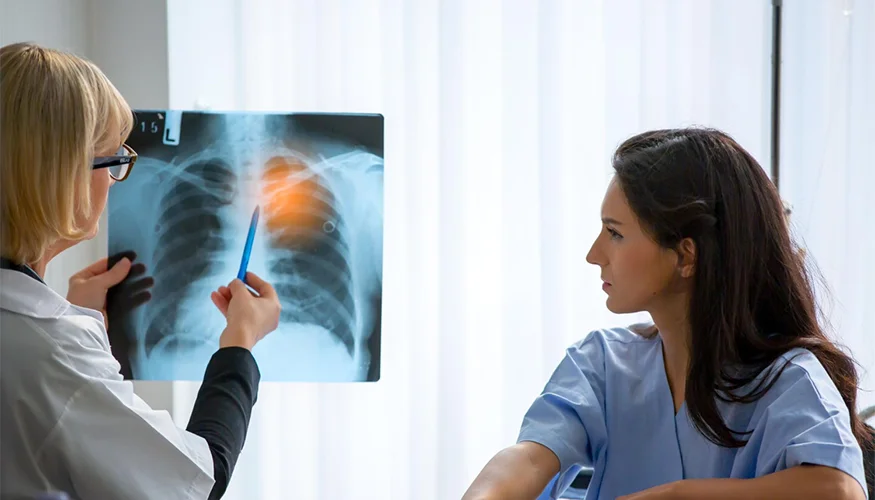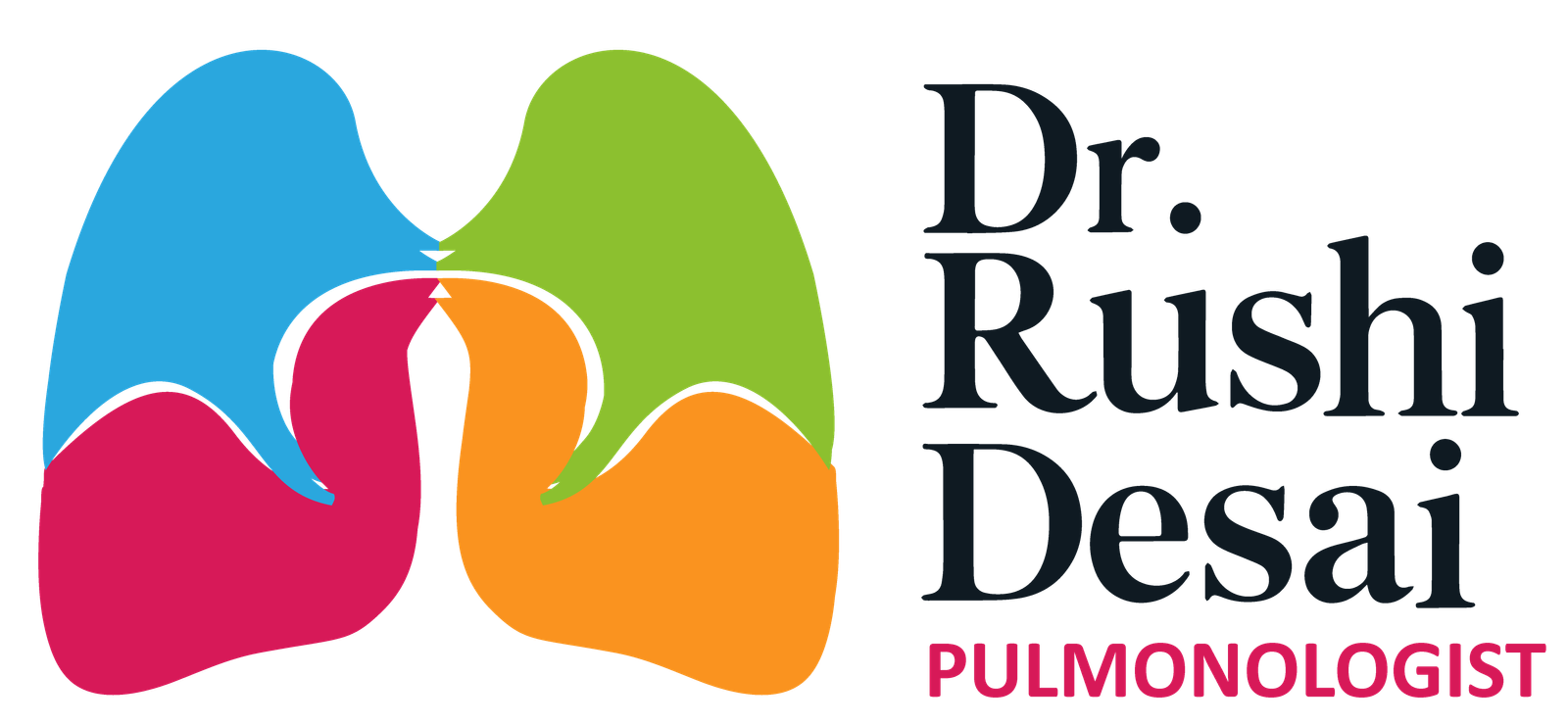
Lung Disease Specialist in Ahmedabad
Are you searching for a highly skilled lung specialist in Ahmedabad? Look no further than Dr. Rushi Desai, the premier pulmonologist renowned for his dedication to exceptional patient care. With extensive experience and expertise in treating occupational lung diseases, Dr. Rushi Desai is committed to improving the respiratory health and overall well-being of his patients.
What are occupational lung diseases?
Occupational lung diseases are respiratory conditions caused or exacerbated by exposure to harmful substances in the workplace. These diseases can affect the lungs and airways, leading to chronic health issues. Common culprits include dust, chemicals, fumes, and other airborne pollutants encountered in various industries.
Types of occupational lung diseases
-
- Pneumoconiosis: Caused by inhaling dust particles, leading to lung tissue scarring. Examples include:
- Asbestosis: From asbestos fibres.
- Silicosis: From silica dust.
- Coal Workers’ Pneumoconiosis (Black Lung Disease): From coal dust.
- Occupational Asthma:
- Pneumoconiosis: Caused by inhaling dust particles, leading to lung tissue scarring. Examples include:
Triggered by inhaling workplace irritants such as chemicals, fumes, or dust, leading to airway inflammation and constriction.
- Chronic Obstructive Pulmonary Disease (COPD): Long-term exposure to irritants like tobacco smoke, chemical fumes, and dust can contribute to COPD development.
- Hypersensitivity Pneumonitis: An allergic reaction to inhaled organic dust, fungi, or molds, causing inflammation of the lung’s air sacs.
- Occupational Bronchitis: Chronic bronchitis resulting from long-term exposure to respiratory irritants in the workplace.
What causes occupational lung disease?
Occupational lung diseases are primarily caused by inhaling harmful substances in the workplace, such as:
- Dust: Asbestos, silica, coal, wood, and metal dust.
- Fumes: Welding fumes, metal fumes, and chemical fumes.
- Gases: Chlorine, ammonia, and sulfur dioxide.
- Vapors: Solvents, paints, and cleaning agents.
- Molds and Fungi: Present in damp or water-damaged environments.
What are the symptoms of occupational lung diseases?
Symptoms can vary depending on the specific disease but commonly include:
- Chronic cough
- Shortness of breath
- Wheezing
- Chest tightness
- Fatigue
- Difficulty breathing during physical activity
How is occupational lung disease diagnosed?
Early diagnosis of occupational lung diseases is crucial for effective treatment and prevention of further damage. Dr. Rushi Desai employs a comprehensive approach to diagnosis, which includes:
- Medical History: A detailed assessment of the patient’s occupational history, exposure to harmful substances, and symptom timeline.
- Physical Examination: A thorough physical examination focusing on respiratory function and identifying any signs of lung disease.
- Pulmonary Function Tests (PFTs): Pulmonary Function Tests to measure lung capacity, airflow, and gas exchange efficiency.
- Imaging Studies: Chest X-rays or CT scans to detect lung abnormalities, scarring, or inflammation.
- Laboratory Tests: Blood tests and sputum analysis to identify infections or inflammatory markers.
- Bronchoscopy: A Bronchoscopy procedure where a thin tube with a camera is inserted into the airways to examine the lungs and collect tissue samples if needed.
Don’t compromise on your respiratory health. Trust Dr. Rushi Desai, the best pulmonologist in Ahmedabad, to deliver the exceptional care you deserve. Contact us today to schedule an appointment and take the first step towards better lung health.
Need a help ?
Best Treatments
Our Best Treatments
Asthma and Allergy Tests are diagnostic procedures used to identify specific allergens that trigger asthma or allergic reactions. These tests help in understanding the causes of respiratory issues and allergic symptoms, enabling precise treatment and management.
- Asthma Tests: Include lung function tests like spirometry, which measure the amount and speed of air a person can inhale and exhale, helping to diagnose and monitor asthma severity.
- Allergy Tests: Commonly involve skin prick tests or blood tests (such as ImmunoCAP) to detect allergic sensitivities to various substances like pollen, dust mites, pet dander, or certain foods.
Chronic Obstructive Pulmonary Disease (COPD) is a progressive lung disease characterized by persistent respiratory symptoms and airflow limitation due to airway and/or alveolar abnormalities. It includes conditions such as emphysema and chronic bronchitis. Early detection and management are crucial in slowing the progression of COPD and reducing the risk of complications.
Read More about COPDLung Cancer is a serious disease where abnormal cells grow uncontrollably in the lungs, forming tumors. The main types are non-small cell lung cancer (NSCLC) and small cell lung cancer (SCLC). Common symptoms include persistent cough, chest pain, shortness of breath, and coughing up blood. Lung cancer is detected through imaging tests such as X-rays and CT scans and confirmed with a biopsy. Early detection significantly improves treatment success and survival rates.
Read More about Lung CancerInterstitial Lung Disease (ILD) is a group of disorders characterized by progressive scarring (fibrosis) of the lung tissue, which affects the interstitium the network of tissue that supports the lungs' air sacs (alveoli). This scarring makes it difficult for the lungs to expand and contract properly, leading to breathing difficulties and reduced oxygen supply to the bloodstream.
Read More about Interstitial Lung disease
Tuberculosis (TB) is an infectious disease caused by the bacterium Mycobacterium tuberculosis. It primarily affects the lungs but can also impact other parts of the body such as the kidneys, spine, and brain. TB spreads through airborne droplets when an infected person coughs or sneezes. TB is treatable and curable with a strict regimen of antibiotics taken over several months. Early detection and adherence to the prescribed treatment are essential to prevent the spread of the disease and to achieve a full recovery.
Read More about TuberculosisSleep Apnoea is a sleep disorder characterized by repeated interruptions in breathing during sleep. These interruptions, called apnoeas, can last from a few seconds to a minute and can occur numerous times throughout the night. The most common type is obstructive sleep apnoea (OSA), which occurs when the throat muscles relax and block the airway. Central sleep apnoea (CSA), a less common form, happens when the brain fails to send proper signals to the muscles that control breathing.
Read More about Sleep Apnoea
Occupational Lung Diseases are respiratory conditions caused by exposure to harmful substances in the workplace. These diseases can result from inhaling dust, chemicals, fumes, or other hazardous materials over an extended period.
Read More about Occupational Lung DiseasesPleural Effusion is a condition where excess fluid accumulates in the pleural space, the thin cavity between the lungs and the chest wall. This fluid buildup can compress the lungs, making it difficult to breathe and causing chest pain.
Read More about Pleural DiseasesRigid Bronchoscopy is a medical procedure used to examine and treat problems in the airways (bronchi) and lungs using a rigid, hollow tube called a bronchoscope. Unlike flexible bronchoscopy, which uses a flexible tube, rigid bronchoscopy allows for larger instruments to be passed through the tube, facilitating interventions.
Read More about BronchoscopyEBUS (Endobronchial Ultrasound) refers to two types: Linear and Radial EBUS, both of which are advanced bronchoscopic techniques used for detailed imaging and biopsy of structures near the lungs. Both types of EBUS are minimally invasive procedures performed under sedation or general anesthesia by pulmonologists or interventional bronchoscopists.
Read More about EBUS (Linear & Radial)
Rigid Thoracoscopy is a minimally invasive surgical procedure used to examine and treat conditions affecting the chest cavity, specifically the pleural space (the area between the lungs and the chest wall). It involves the use of a rigid thoracoscope, a tubular instrument with a camera and light source at its tip, which is inserted through a small incision made in the chest wall.
Read More about ThoracoscopyPediatric Bronchoscopy is a medical procedure used to examine and treat the airways (bronchi and bronchioles) in children. It involves inserting a flexible or rigid bronchoscope through the nose or mouth and into the airways, allowing direct visualization and access to the lungs.
Read More about EBUS (Linear & Radial)
Tracheal Stenting is a medical procedure used to treat narrowing or obstruction of the trachea (windpipe) by inserting a stent—a small, flexible tube—into the affected area to keep it open. This procedure is typically performed in cases where there is significant narrowing of the trachea due to conditions such as: Tumors, Trauma, Inflammatory Conditions, and Congenital Anomalies.
Read More about Tracheal Stenting
Lung Transplantation is a surgical procedure performed to replace one or both diseased lungs with healthy lungs from a deceased donor. This complex procedure is typically considered for patients with end-stage lung disease that cannot be adequately treated with other medical or surgical interventions.
Read More about Lung TransplantsTracheal Stenosis Repair is a surgical procedure aimed at correcting narrowing or constriction of the trachea (windpipe), which can restrict airflow and lead to breathing difficulties.
Read More about Tracheal stenosis repair
Endobronchial Tumour Debulking is a procedure performed to remove or reduce the size of tumors located within the bronchial airways using various techniques and tools. This approach is often used to relieve symptoms such as coughing, wheezing, and shortness of breath caused by obstructive tumors.
Read More about Endobronchial tumour debulking
Lung Cryo Biopsies (or Cryo Lung Biopsies) are minimally invasive procedures used to obtain tissue samples from the lungs for diagnostic purposes. This technique involves using extreme cold to freeze and then remove a small piece of lung tissue, which is then examined under a microscope to identify and diagnose lung conditions such as interstitial lung diseases, lung infections, and lung cancers.
Read More about Lung Cryo biopsiesAblation of Lung Cancer Lesions refers to the targeted destruction or removal of cancerous lesions in the lungs using various minimally invasive techniques. These procedures are typically performed when surgery is not an option or as part of a comprehensive treatment plan to manage lung cancer.
Read More about Ablation of lung cancer lesionsBalloon Dilatation is a medical procedure used to widen narrowed or obstructed passages within the body, such as blood vessels or airways, using an inflatable balloon. In the context of respiratory medicine, balloon dilatation is commonly performed to alleviate narrowing in the airways (bronchi) caused by conditions such as: Tracheal Stenosis and Bronchial Stenosis.
Read More about Balloon Dilatation
Aspirated Foreign Body Removal is a medical procedure performed to extract objects or substances that have been accidentally inhaled into the airways (trachea, bronchi) or lungs. This commonly occurs in children but can also affect adults, leading to respiratory distress and potentially life-threatening complications if not promptly addressed.
Read More about Aspirated foreignbody removal
Bronchial Thermoplasty is an innovative procedure used to treat severe asthma by targeting the smooth muscle lining the airways (bronchi). This procedure aims to reduce the excessive smooth muscle that contributes to airway constriction in asthma patients, thereby improving asthma control and reducing symptoms.
Read More about Bronchial ThermoplastyPulmonary Function Testing (PFT) refers to a group of non-invasive tests that assess how well the lungs are functioning. These tests measure various aspects of lung capacity, airflow, and gas exchange to help diagnose respiratory conditions, monitor lung diseases, and evaluate lung function before surgery or as part of occupational health assessments.
Read More about Pulmonary Function TestA Sleep Study, also known as polysomnography (PSG), is a diagnostic test used to evaluate sleep patterns and diagnose sleep disorders. It involves monitoring various physiological parameters during sleep to assess factors such as breathing patterns, brain activity, heart rate, and body movements.
Read More about Sleep DisordersAn Allergy Skin Test is a diagnostic procedure used to identify specific allergens that may be triggering allergic reactions in an individual. It is a common method used by allergists and immunologists to diagnose allergies such as allergic rhinitis (hay fever), asthma, eczema, food allergies, and allergic reactions to medications or insect stings.
Read More about Allergy Skin TestThe Respiratory Intensive Care Unit (ICU) is a specialized medical unit within a hospital that provides intensive care and monitoring for patients with severe respiratory illnesses and conditions. It is staffed by a multidisciplinary team of healthcare professionals trained in critical care and respiratory medicine, including pulmonologists, intensivists, respiratory therapists, nurses, and support staff.
Read More about Respiratory ICU

